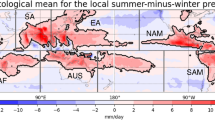Abstract
Several studies have shown that the use of different calendars in paleoclimate simulations can cause artificial phase shifts on insolation forcing and climatic responses. However, these important calendar corrections are still often neglected. In this paper, the phase shifts at the precession band is quantitatively assessed by converting the model data of the transient GCM climate simulation of Kutzbach et al. (Clim Dyn 30:567–579, 2008) from the “fixed-day” calendar to the “fixed-angular” calendar with a new and efficient approach. We find that insolation has a big phase shift in September–October–November (SON) when the vernal equinox (VE) is fixed to March 21. At high latitude, the phase bias is up to 60° (about 3650 years). The insolation phase bias in SON in Southern Hemisphere (SH) is especially important because it can influence the timing of the SH summer monsoon response due to the large heat capacity of ocean. The calendar correction has minor effect (±2°) on the phase relationships between forcing and precipitation responses of the six global summer monsoons studied in Kutzbach et al. (2008). After correcting the calendar effect, especial on SH ocean temperature, the new phase wheel results are more similar for both hemispheres. The results suggest that the calendar effect should be corrected before discussing the dynamics between orbital forcing and climatic responses in phase studies of transient simulations.







Similar content being viewed by others
References
Berger AL (1978) Long-term variations in daily insolation and Quaternary climate changes. J Atmos Sci 35:2362–2367
Chen G-S, Liu Z, Clemens SC, Prell WL, Liu X (2010) Modeling the time-dependent response of the Asian Summer Monsoon to obliquity forcing in a coupled GCM: a PHASEMAP sensitivity experiment. Clim Dyn. doi:10.1007/s00382-010-0740-3
Clemens SC, Prell WL, Murray D, Shimmield G, Weedon G (1991) Forcing mechanisms of the Indian Ocean monsoon. Nature 353:720–725
Hewitt CD, Mitchell JFB (1998) A fully coupled general circulation model simulation of the climate of the mid-Holocene. GRL 25:361–364
Imbrie J, Mclntyre A, Mix A (1989) Oceanic response to orbital forcing in the late Quaternary: observational and experimental strategies. In: Berger A, Schneider S, Duplessy JC (eds) Climate and geosciences. Kluwer, Boston
Jackson CS, Broccoli AJ (2003) Orbital forcing of Arctic climate: mechanisms of climate response and implications for continental glaciation. Clim Dyn 21:539–557
Jenkins GM, Watts DG (1968) Spectral analysis and its applications. Holden Day, Oakland
Joussaume S, Braconnot P (1997) Sensitivity of paleoclimate simulation results to season definition. J Geophys Res 102(D2):1943–1956
Kutzbach JE (1981) Monsoon climate of the early Holocene: climate experiment with the earth’s orbital parameters for 9000 years ago. Science 214:59–61
Kutzbach JE, Gallimore RG (1988) Sensitivity of a coupled atmosphere/mixed-layer ocean model to changes in orbital forcing at 9000 yr BP. J Geophys Res 93:803–821
Kutzbach JE, Otto-Bliesner BL (1982) The sensitivity of the African-Asian monsoonal climate to orbital parameter changes for 9000 yr B.P. in a low-resolution general circulation model. J Atmos Sci 39(6):1177–1188
Kutzbach JE, Liu X, Liu Z, Chen G-S (2008) Simulation of the evolutionary response of global summer monsoon to orbital forcing over the past 280,000 years. Clim Dyn 30:567–579
Liu Z, Otto-Bliesner BL, Kutzbach JE, Li L, Shields C (2003) Coupled climate simulation of the evolution of global monsoon in the Holocene. J Clim 16:2472–2490
Liu Z, Wang Y, Gallimore R, Notaro M, Prentice IC (2006) On the cause of abrupt vegetation collapse in North Africa during the Holocene: climate variability vs. vegetation feedback. Geophys Res Lett 33:L22709. doi:10.1029/2006GL028062
Lorenz SJ, Lohmann G (2004) Accelerated technique for Milankovitch type forcing in a coupled atmosphere-ocean circulation model: method and application for the Holocene. Clim Dyn 23:727–743
Milankovitch M (1941) Kanon der Erdbestrahlung und seine Anwendung auf das Eiszeitenproblem. Ed. Spec. Sect. Sci. Math. Nat. 33, Acad. Serbe, R., Belgrade
Mitchell JFB, Grahame NS, Needham KJ (1988) Climate simulations for 9000 years before present: seasonal variations and effects of the Laurentide ice sheet. J Geophys Res 93(D7):8283–8303
Montoya M, Von Storch H, Crowley TJ (2000) Climate simulation for 125,000 years ago with a coupled ocean-atmosphere general circulation model. J Clim 13:1057–1072
Pollard D, Reusch DB (2002) A calendar conversion method for monthly mean paleoclimate model output with orbital forcing. J Geophys Res 107(D22):4615. doi:10.1029/2002JD002126
Thomson DJ (1995) The seasons, global temperature, and precession. Science 268(5207):59–68. doi:10.1126/science.268.5207.59
Timm O, Timmermann A, Abe-Ouchi A, Saito F, Segawa T (2008) On the definition of seasons in paleoclimate simulations with orbital forcing. Paleoceanography 23:PA2221. doi:10.1029/2007PA001461
Timmermann A, Lorenz S, An S-I, Clemens A, Xie S-P (2007) The effect of orbital forcing on the mean climate and variability of the tropical Pacific. J Clim 20:4147–4159
Acknowledgments
The authors are grateful to the editor and the two anonymous reviewers. Their constructive comments significantly improved the paper. We also thank David Pollard for providing their code. The simulations were made at the NSF-sponsored computing facility of NCAR, Boulder, Co. This work was jointly supported by US NSF grants, Natural Science Foundation of China (40825008) and National Basic Research Program of China (2010CB833406).
Author information
Authors and Affiliations
Corresponding author
Rights and permissions
About this article
Cite this article
Chen, GS., Kutzbach, J.E., Gallimore, R. et al. Calendar effect on phase study in paleoclimate transient simulation with orbital forcing. Clim Dyn 37, 1949–1960 (2011). https://doi.org/10.1007/s00382-010-0944-6
Received:
Accepted:
Published:
Issue Date:
DOI: https://doi.org/10.1007/s00382-010-0944-6




